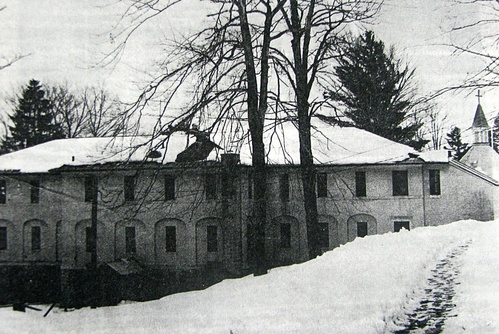 Gabriels Sanatorium, Adirondack Daily Enterprise, March 4, 1989
Gabriels Sanatorium, Adirondack Daily Enterprise, March 4, 1989  A 1908 patient's postcard (Courtesy of Howard Riley)
A 1908 patient's postcard (Courtesy of Howard Riley) 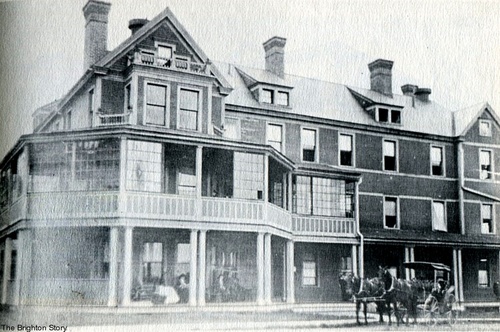 Rest-A-While Cottage at Gabriels Sanatorium
Rest-A-While Cottage at Gabriels Sanatorium 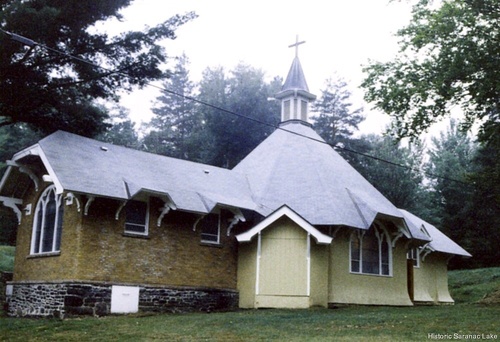 Gabriels Chapel, 1977, First TB Reunion Gabriels Sanatorium, opened in 1894 by the Sisters of Mercy, was only the second sanatorium in the area, a very early charitable effort which built on the work of Dr. E. L. Trudeau. Gabriels was the first sanatorium in the Adirondacks to admit black patients. 1Henry Gabriels served as the Bishop of the Diocese of Ogdensburg from May 5, 1892, to April 23, 1921, when he apparently died in office at age 82. 2
Gabriels Chapel, 1977, First TB Reunion Gabriels Sanatorium, opened in 1894 by the Sisters of Mercy, was only the second sanatorium in the area, a very early charitable effort which built on the work of Dr. E. L. Trudeau. Gabriels was the first sanatorium in the Adirondacks to admit black patients. 1Henry Gabriels served as the Bishop of the Diocese of Ogdensburg from May 5, 1892, to April 23, 1921, when he apparently died in office at age 82. 2
When it was built, the location was known as Paul Smith's Station, and the sanatorium was not called "Gabriels Sanatorium," a name that does not appear in newspaper archives until 1903. The area acquired the name Gabriels from the sanatorium.
Haakon Engh and Trygve Magnussen were among the Norwegian sailors who came to Saranac Lake; they both died at the Gabriels Sanatorium. Theodora Becker and John McCrank were also patients there. Father Patrick Gallery worked at Gabriels Sanatorium for a time in the early 1920s.
After the sanatorium closed, Paul Smith's College purchased the property in August 1965, as an extension center for their growing Forestry Program. PSC closed the Gabriels campus in 1980, and sold the facility to the State of New York to be used for a minimum security prison.
Camp Gabriels received its first draft of inmates on August 30, 1982. These residents were transferred from the Adirondack Correctional Facility, which had been upgraded from a Camp to a Medium Security Facility. Camp Gabriels operated until 2009, when it was closed by Governor Andrew Cuomo. It has been for sale by the state since then, and was sold in early 2014, according to the Adirondack Daily Enterprise.
The Rev. George Wichland, a missionary priest, cured at Gabriels Sanatorium.
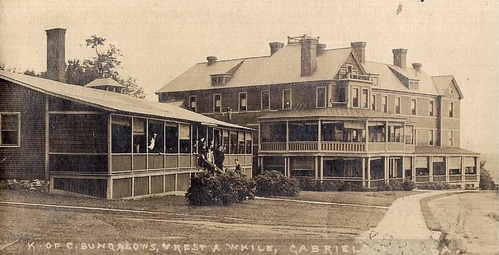 Rest-A-WhileMalone Gazette, July 5, 1895
Rest-A-WhileMalone Gazette, July 5, 1895
Propositions will be received by the Sisters of Mercy for the building of the Sanitarium Gabriels, Paul Smith's, N. Y. The plans and specifications are to be seen at Mr. Patrick Hackett's, hardware merchant, Ogdensburg, N. Y. The bids to be handed in to Mr. Wm. Akin, architect, Ogdensburg, N. Y., before July 6th. The Sisters do not bind themselves to accept the lowest bid.
Malone Gazette, July 5, 1895
The corner stone of the Gabriels Sanitarium for consumptives at Paul Smith's, which will be built by the Sisters of Mercy of the diocese of Ogdensburg, will be laid July 8th with imposing ceremonies by Bishop Gabriels. Archbishop Corrigan and other prominent church officials will be present. It is announced that Gov. Morton has made a generous contribution to the building fund with the request that the Sisters give the name of Anna L. Morton, the governor's wife, to a room or ward in the sanitarium.
New York Times, June 27, 1897 (A pdf of the full article is here)
ON MOUNTAINS AND LAKES
The Numerous Adirondack Resorts Now Ready to Receive the Summer Visitor.
 Administration Building, Rest-A-While...A large sanitarium has been erected in the vicinity of Paul Smith's, under the auspices of the Sisters of Mercy, on land donated for the purpose by Dr. Webb. The plan of the institution embraces the best features of hotel and cottage life, and it is the design of the incorporators to charge persons no more than is necessary to meet the expenses, thus enabling sufferers of limited means to take advantage of an opportunity to breathe the mountain air. It is also the purpose of the managers of this institution to make no distinction against any patient on account of creed.
Administration Building, Rest-A-While...A large sanitarium has been erected in the vicinity of Paul Smith's, under the auspices of the Sisters of Mercy, on land donated for the purpose by Dr. Webb. The plan of the institution embraces the best features of hotel and cottage life, and it is the design of the incorporators to charge persons no more than is necessary to meet the expenses, thus enabling sufferers of limited means to take advantage of an opportunity to breathe the mountain air. It is also the purpose of the managers of this institution to make no distinction against any patient on account of creed.
Malone Gazette, August 6, 1897
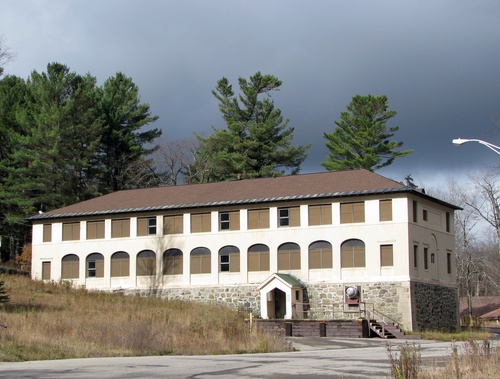 One of two identical dormitories, 2013.Bishop Gabriels recently announced that Sanitarium Gabriels, near Paul Smith's Station, will be dedicated on August 21st. The sanitarium, the site for which was generously donated by Paul Smith and Dr. W. Seward Webb, has been built with special reference to the care and treatment of consumptives and will be owned and controlled by the Sisters of Mercy, an order that for good and charitable deeds has won a high and deserved place in the confidence and respect of the people. The sanitarium will be dedicated with appropriate and interesting ceremonies.
One of two identical dormitories, 2013.Bishop Gabriels recently announced that Sanitarium Gabriels, near Paul Smith's Station, will be dedicated on August 21st. The sanitarium, the site for which was generously donated by Paul Smith and Dr. W. Seward Webb, has been built with special reference to the care and treatment of consumptives and will be owned and controlled by the Sisters of Mercy, an order that for good and charitable deeds has won a high and deserved place in the confidence and respect of the people. The sanitarium will be dedicated with appropriate and interesting ceremonies.
Plattsburgh Republican, July 30, 1904
Sanitarium Gabriels is crowded with patients, and ten street cars have been provided for invalids , which are found to be much better than tents, being dryer, warmer and lighter.
From Seneca Ray Stoddard's 1908 The Adirondacks, Illustrated
The Sanitarium Gabriels [...] was opened in 1897. A group of substantial cottages surround the larger Administration Building. Patients suffering from lung troubles, who are pronounced curable by competent authority, are eligible. For such the rates are $10 to $15 per week, with every tenth patient free. There is no discrimination on account of race or creed. It is in charge of the Sisters of Mercy, who may be addressed at Gabriels, N. Y.
"Forest Leaves," a woodsy little magazine, is published here quarterly. Its cover is a dream, its contents of gentle, wholesome character, suggested by its title.
Ogdensburg Journal, January 19, 1916
300 MEN WORK HARD TO SAVE GABRIELS FROM THE ASH HEAP
Patients Routed Out by Fire Had to Flee, Seizing Coverings as They Ran—Sisters Started With $15, Present Value $250,000.
Saranac Lake, Jan. 11.—Flames, which broke out in the attic of the administration building of the Gabriels Sanatorium about 7 o'clock yesterday morning, destroyed that building and for hours threatened to destroy the other buildings of the sanatorium. It was only by the work of 300 men that the entire institution was saved from the ash heap.
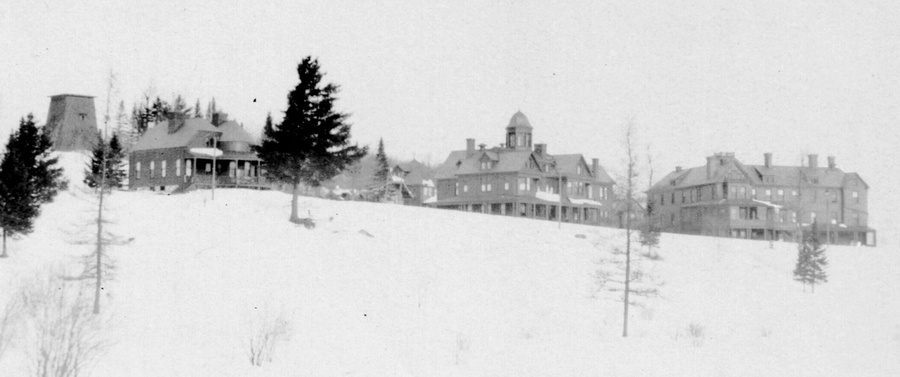 Detail of a postcard titled "Sanatorium Gabriels, N.Y." undated. Rest-A-While Cottage at right, Administration Building, center, Kerin Cottage at left.
Detail of a postcard titled "Sanatorium Gabriels, N.Y." undated. Rest-A-While Cottage at right, Administration Building, center, Kerin Cottage at left.
Photo by E. L. Gray & Co., Saranac Lake, NY.
Historic Saranac Lake collection, #2021.3.118a. Gift of the Florence Wright Tuberculosis Postcard Collection.The fire was discovered about 7 o'clock in the attic of the administration building, the large two and one-half story frame structure, which was the first of the main group of buildings on the right hand side of the drive. The fire originated from a defective flue and spread rapidly throughout the upper part of the building, finally eating its way to the lower stories.
When the fire broke out there were about 25 patients in the building. All were removed to other buildings and some of the furniture was also removed from the building.
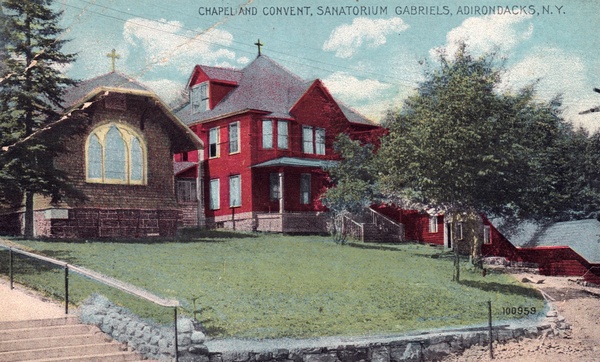 Hand-tinted postcard showing the chapel and convent at Gabriels Sanatorium, mailed October 13, 1914
Hand-tinted postcard showing the chapel and convent at Gabriels Sanatorium, mailed October 13, 1914
Historic Saranac Lake collection, #2021.3.117. Gift of the Florence Wright Tuberculosis Postcard Collection.
With a strong wind blowing from the southwest the other buildings in the group were directly in the path of the flames which were blown from the administration building. Restawhile, the largest cottage of the sanatorium, seemed doomed, also.
A call for help was sent over the telephone wires in all directions. Paul Smiths Hotel company gathered all men from all work on the ice, in the mill, store, shops and woods and hurried them to the sanatorium. Every man turned out along the highways in Gabriels, Rainbow and vicinity.
The Saranac Lake fire department was called upon, for help and a special train was made up to carry men and apparatus. This train left Saranac Lake at 8:55 and arrived in the nick of time to check the flames as they threatened Restawhile.
The sanatorium was filled with patients, there being about 70 in number quartered in the different buildings.
As soon as the fire became known at the Foresters' Sanitarium at Rainbow Lake, Dr. J. Seymour Emans, the superintendent of the Foresters' Sanitarium, offered to take care of the patients from Gabriels and they were removed to Rainbow.
There was no serious accident or injury reported to either the firemen or the patients.
The fire was discovered by men who were on their way to work harvesting ice in the vicinity.
Many of the patients who were in bed had to flee for their lives and lost their clothing except what garments they could seize as they ran.
The special train from Saranac Lake with about 50 firemen, hose and ladders, reached Gabriels at 9:30 and at once carried the equipment to the sanatorium.
Then it was found that the hose of the Saranac Lake fire department, which is of the standard size, would not fit the Gabriels hydrant. The Chapel, 2013
The Chapel, 2013
By this time the building was in ruins and the Saranac Lake firemen joined the people of Gabriels and Paul Smiths and the patients and employees of the sanatorium in their efforts to keep the roofs and sides of the other buildings from getting on fire.
The Sisters worked with heroism and patience in the zero temperature and in face of the ruination of their institution to supply hope and cheer to the patients who were forced out of their beds, and to supply coffee to the fire fighters.
Only a little of the furniture was saved. It was thrown from the windows into snow drifts. It is likely the loss will be about $25,000. It is not known at this time what will be done about rebuilding the administration building.
The Stony Wold Sanitarium at Lake Kushaqua was quick to offer assistance and quarters for the patients who were forced out of Gabriels by the flames.
Gabriels Sanitorium was started in May, 1895, with $15 in hand. The Sisters of Mercy in eight years, or by 1903, had collected and expended in buildings the sum of $135,000 and won a prize at the Paris World's Fair for certain features of the sanatorium.
The Paris Exposition has awarded a medal to Sanatorium Gabriels as a reward for the arrangement, construction, water, supply, drainage, warming and ventilating of the several buildings. The amount that has been expended at Gabriels is nearly $250,000.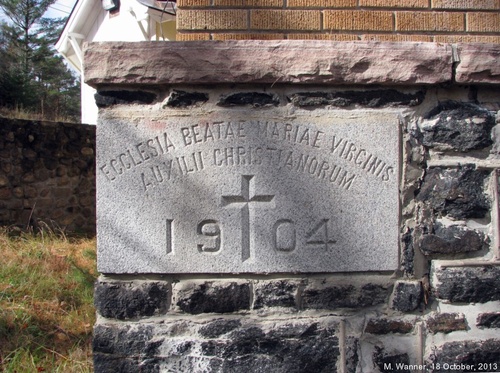 ECCLESIA BEATAE MARIAE VIRGINIS AUXILII CHRISTIANORUM
ECCLESIA BEATAE MARIAE VIRGINIS AUXILII CHRISTIANORUM
Church of the Blessed Virgin Mary, help of Christians.
First Benefactor Dies.
Mrs. Ann Schenick Kerin, who gave the first contribution for the Sanatorium Gabriels, died at her home in Troy Thursday from injuries and shock suffered when her automobile collided with an United Traction car in North Troy two weeks ago.
Mrs. Kerin was born in Ireland. When she was young her parents moved to Albany where she lived for years. Mrs. Kerin was known for her charities. She gave the first contribution for the Saratorium Gabriels and gave extensively to the Troy hospital and to St. Mary's church. She was a member of the Rosary society of the church. She was aged 80 years, the widow of James Kerin, a wealthy Troy grocer.
Sanatorium Gabriels in Charge of the Sisters of Mercy.
Sanatorium Gabriels, for those in the first stages of tuberculosis, in charge of the Sisters of Mercy, was formally opened July 26th, 1897. The land is situated on an undulating plan at the former Paul Smiths Station and present Gabriels Station of the New York Central railroad, and consists of a broad park running along the side of the railroad and rising gradually to a beautiful hill, “Sunrise Mount,” which, like a screen, shades the valley from the north winds.
All around it lie the mountains of the Adirondack region, the giants of the range—Mount Marcy, Whiteface, Mt. McGregor, etc., etc., while not very far away beautiful Lucretia Lake spreads its waters.
The advisory committee for a long time was composed of the following: Hon. Theodore Roosevelt, W. Seward Webb, Mrs. W. Seward Webb, Paul Smith, Mrs. Levi P. Morton, David McClure, Mrs. David McClure, Mrs. H. Walter Webb, Miss Annie Leary, Mrs. John Kelly, Mrs. Morgan, J. O'Brien, Mrs. DeVillers Hoard, Stephen Moffit, Thos. B. Cotter, W. Bourke Cockran, W. E. Kerin, Mrs. Thomas P. Ryan, Miss K. G. Broderick, F. C. Travers, John F. O'Brien, Clarence H. Mackay, Thomas F. Conway, Mrs. J. G. Agar, Mrs. W. R. Grace, Edward Eyre, John T. McDonough, I. G. Perry, Mrs. I. G. Perry, H. D. Stevens.
The sanatorium grew out of the idea, study and sympathetic efforts of Sister Mary P. H. Kieran, who was both founder, builder' and for many year: administrator at the sanatorium. Her death occurred in 1914.
The following history is based on a document at the New York State Office of General Services. It was posted in connection with the state's efforts to sell the property. The full document can be found here.
GABRIELS SANITARIUM, 1897 – 1965
Gabriels Sanitarium opened on July 16, 1897, for treatment of Tuberculosis invalids in the Adirondacks. It was named in honor of the Right Reverend Bishop Henry Gabriels who had urged the Sisters of Mercy to attempt the establishment of the much needed sanitarium.
Sister Mary of the Perpetual Help Kiernan, of the Sisters of Mercy Order, used her untiring faith and energy to make her dream a reality. Sister Mary and her co-worker Sister McAuley lived in a log cabin with the gift of a donkey and cart for transportation. Within a few years, although they only had $15 from the Mother House and a lot of determination to work with, they acquired the site and several buildings.
Dr. Seward Webb and Mr. Paul Smith donated the first 100 acres of land and the State of New York followed with a grant of 600 additional acres. Many people gave generously and donations were used to support the property.
Only those with at least moderately advanced cases of Tuberculosis were admitted as patients. When they entered, they were not only treated for Tuberculosis, but also were taught every detail of prevention so they might tell others and possibly prevent other cases from developing. Fifteen per cent of the patients were treated free of charge, a few paid the entire cost, and most patients paid less than the full cost of treatment. The average patient's length of stay was eight months.
The Sanitarium flourished through the hard work and dedication of its staff, and despite the destruction of several buildings due to fire over the course of its history.
However, after World War II, the decline of Tuberculosis forced the Sanitarium staff to devote most of their facilities to geriatric patients. In the 68 years of the sanitarium's operation, over 5,500 patients were treated. Sixty-nine per cent of the patients benefited from treatment and a great number were able to return to their former lives.
After a series of unsuccessful fund drives and a re-evaluation of the Sanitarium's new nursing program, the Sisters decided to sell the property.
PAUL SMITH'S GABRIELS CAMPUS 1965 – 1980
On August 15, 1965, Paul Smith's College purchased the Gabriels Sanitarium property for $150,000 as an extension center for their growing Forestry Program.
Gabriels housed the sophomore foresters enrolled in a block program for the fall term. Later classes were held there, as well, to avoid having to provide transportation to the main campus. Classes were taught in the basement of Rest-a-While Cottage, while the Butler Building served as classrooms and a cafeteria. The Butler Building was built in the early 1970s as a gymnasium, but it was later used as a cafeteria and for additional classroom space.
By 1977, declining enrollment led to buildings deteriorating due to disuse, and the school started moving the different options of the Forestry Program back to the main campus. Finally only the forest technicians were at Gabriels. Also, in 1979-80 two new dormitories were constructed and opened to students, which provided additional space on campus so that only thirty-five students went to Gabriels to live for the last time. The Gabriels campus had become such a financial liability that the administration opened up two additional cottages on the main campus, Moffet and Walker, for the Spring semester to house the thirty-five remaining students. The fall term of 1980 was the last to see Paul Smith's students at the Gabriels campus. By this time, it was being used only as dormitory space— all classes and dining services were at the main campus.
The college then sold the facility to the State of New York to be used for a minimum security prison.
HISTORY OF CAMP GABRIELS 1982 – PRESENT
Camp Gabriels received its first draft of inmates on August 30, 1982. These residents were transferred to Camp Gabriels from the Adirondack Correctional Facility, which had been upgraded from a Camp to a Medium Security Facility. The first group of twenty-five inmates was selected because of their building skills. These men were all housed on one floor in the first housing unit and proceeded to refurbish the second floor and the other housing unit areas in a systematic fashion. As additional housing areas were reconstructed, more inmates were received at the facility.
The Camp's maximum capacity was initially designated at 149. A year later in the Fall of 1983, the Camp experienced a modest increase; the capacity was increased from 149 to 166. The next expansion occurred two years after the Camp's inception. In August of 1984, the capacity was increased to 201 beds. In July of 1987, the population increased to 251 due to the Shock Incarceration Program at other Camps.
After the housing units were refurbished, other buildings in the Camp were systematically upgraded. A new garage was constructed to provide space to work on facility vehicles. A loading dock and crew room were added to the Mess Hall. The first new building to be constructed was used to house staff from the Department of Environmental Conservation (DEC). Equipment and crews were deployed each day from that area. The next major project was the construction of a Vocational Building utilizing inmate and staff labor. The Vocational Building has a lower level that serves as a storeroom for the facility. A new Visiting Room was built using contract labor in January of 1984.
In the Summer of 1984, the chapel was refurbished. It serves primarily as a religious center where services for all faiths are conducted. It also serves as an area where various inmate organizations and groups can meet during evening hours. Educational classes are also conducted in the chapel.
In the fall of 1985, the Recreational complex was completed, containing a basketball area and shower room.
A new Administration Building was constructed in 1986, housing the Superintendent, Senior Counselor, Steward, and Support Staff. A three-bay bus garage and a Mess Hall addition were completed the same year, and the property's roads were resurfaced.
In June 1991, a new 56-man dormitory was completed and future plans are for a similar dorm to be started in the fall of this year. These dorms will replace inmate housing, presently in a wooden structure. These dorms will increase the capacity to over three hundred inmates.
During 1991, budgetary constraints caused a loss of ENCON personnel associated with Correctional Camps. The former ENCON Crews were changed to Community Service Crews. At present, Camp Gabriels has 15 Community Service Crews servicing communities, institutions, and non-profit organizations within a 50-mile radius of this facility.
Camp Gabriels has continued to show a progressive pattern of development since its inception. The mission of Camp Gabriels is to continue to maintain a secure environment while building and to foster positive programming for inmates, with cooperative service to the Community. [Camp Gabriels was closed by New York State in 2009.]
Excerpt from an undated report written for the Sisters of Mercy by Sr. Agnes Martin: 3
Following the Great Depression, Sanatorium Gabriels was experiencing not only financial problems, but also a lack of patients. However, God again showed his interest in the Sisters' work. In the early 1940's, during World War II, a Norwegian ship was torpedoed and sunk. Many men lost their lives, but a number of sailors were rescued. Through their exposure to the sea and elements, it was found that many of these rescued men had developed TB. For some reason, the Norwegian Government could not bring them back to Norway, so made arrangements for their care at Stony Wold Sanatorium, a few miles from Gabriels. These patients, perhaps because of loneliness and lack of communication due to the language barrier, became a problem to Stony Wold due to their drinking and carousing. The Norwegian Officials were at a loss what to do about it, until it was suggested to them to ask the Sisters at Gabriels to take care of them. The Sisters immediately accepted. It was not long before the Sister Nurse in charge had them well under control, and these men had the greatest respect and love for her, as well as all the Sisters. They remained at Gabriels until the end of the war when they returned to their own country. The income derived from their care kept Gabriels going.
GABRIELS SANATORIUM
Original Text from a display at the Brighton History Days, 4 by Pat and Tom Willis
The Sisters of Mercy were founded by Catherine McCauley in Dublin, Ireland, in 1831. Catherine had taken care of an elderly Quaker couple until they died and they left their fortune to her. With this, Sister McCauley built houses for homeless women and schools for poor children. When she died she left an order which grew into the thousands internationally, The Sisters of Mercy.
The Sisters of Mercy of the Ogdensburg Diocese had been considering aiding the victims of TB and wanted to obtain land in the Adirondacks for this purpose. Bishop Gabriels had observed the wretched conditions of patients from New York City and in 1894 urged the Sisters on.
Mother Mary Perpetual Help Kiernan, a woman of courage and vision, along with Sister Mary McCauley, led the exploration for land. Saranac Lake proved too expensive. Finally Paul Smith and William Seward Webb became aware of their need, and offered a large tract which they jointly owned near the railroad station in the Town of Brighton.
“Mother,” said Mr. Webb, “Can you assure me that this land is desired for the use by the Sisters directly?”
“Indeed, I can, Mr. Webb. It is the wish of the Sisters of Mercy to alleviate the distress of the unfortunate victims of tuberculosis,” replied Mother Mary. And so they were given the land.
Mother Mary was delighted. “…we own a vast stretch of wooded land (100 acres) down to Lake Lucretia…it was originally called Jones Pond but I …obtained… the right to change the name…after Mr. Perry’s wife…Mr. Perry is the kind architect who has drawn up the plans for the buildings and is donating his services…the idea is to have a sanatorium built on the cottage plan.”
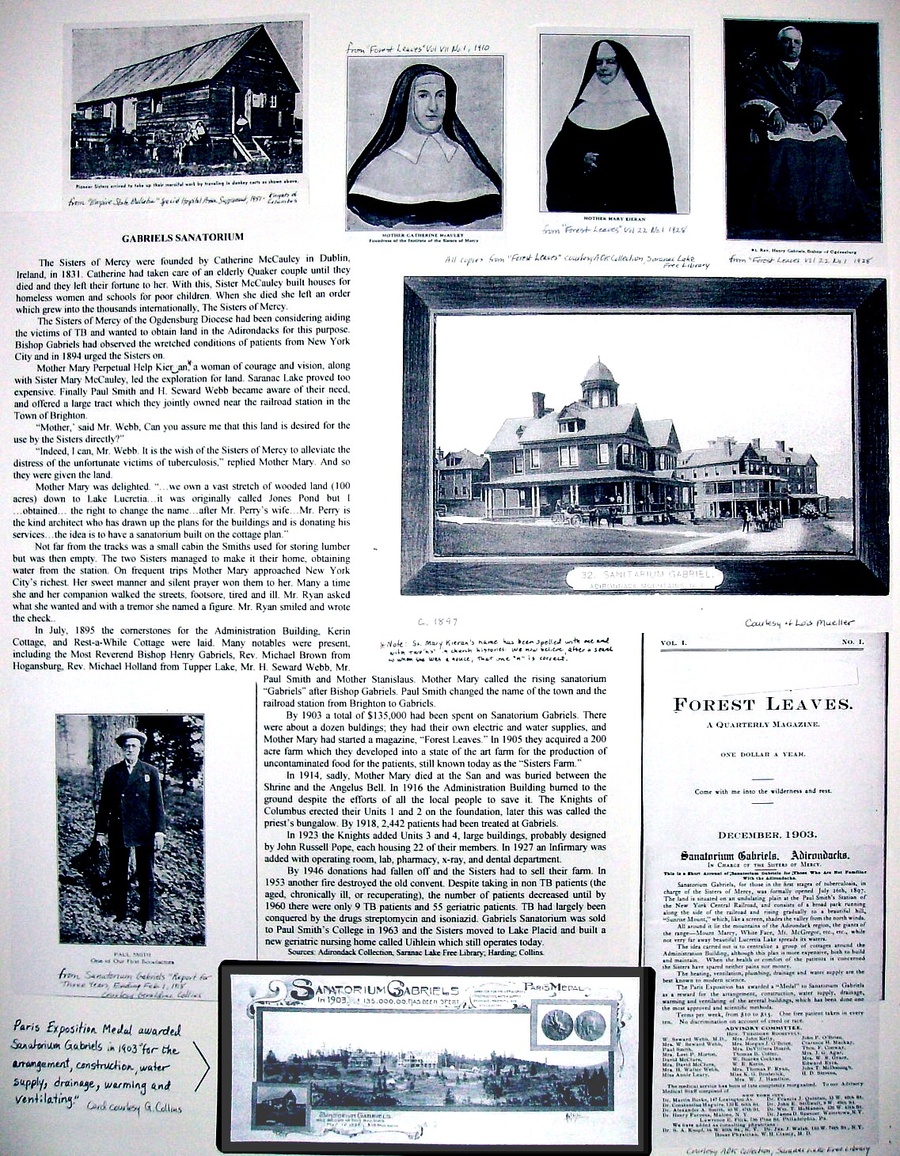 "Gabriels Sanatorium" by Pat and Tom Willis, photo of display taken February 2009. Not far from the tracks was a small cabin the Smiths used for storing lumber but was then empty. The two Sisters managed to make it their home, obtaining water from the station. On frequent trips Mother Mary approached New York City’s richest. Her sweet manner and silent prayer won them to her. Many a time she and her companion walked the streets, footsore, tired and ill. Mr. Ryan asked what she wanted and with a tremor she named a figure. Mr. Ryan smiled and wrote the check.
"Gabriels Sanatorium" by Pat and Tom Willis, photo of display taken February 2009. Not far from the tracks was a small cabin the Smiths used for storing lumber but was then empty. The two Sisters managed to make it their home, obtaining water from the station. On frequent trips Mother Mary approached New York City’s richest. Her sweet manner and silent prayer won them to her. Many a time she and her companion walked the streets, footsore, tired and ill. Mr. Ryan asked what she wanted and with a tremor she named a figure. Mr. Ryan smiled and wrote the check.
In July, 1895 the cornerstones for the Administration Building, Kerin Cottage, and Rest-a-While Cottage were laid. Many notables were present, including the Most Reverend Bishop Henry Gabriels, Rev. Michael Brown from Hogansburg, Rev. Michael Holland from Tupper Lake, Mr. W. Seward Webb, Mr. Paul Smith and Mother Stanislaus. Mother Mary called the rising sanatorium “Gabriels” after Bishop Gabriels. Paul Smith changed the name of the town and the railroad station from Brighton to Gabriels.
By 1903 a total of $135,000 had been spent on Sanatorium Gabriels. There were about a dozen buildings; they had their own electric and water supplies, and Mother Mary had started a magazine, “Forest Leaves.” In 1905 they acquired a 200 acre farm which they developed into a state of the art farm for the production of uncontaminated food for the patients, still known today as the “Sisters Farm.”
In 1914, sadly, Mother Mary died at the San and was buried between the Shrine and the Angelus Bell. In 1916 the Administration Building burned to the ground despite the efforts of all the local people to save it. The Knights of Columbus erected their Units 1 and 2 on the foundation, later this was called the priest’s bungalow. By 1918, 2,442 patients had been treated at Gabriels.
In 1923 the Knights added Units 3 and 4, large buildings, probably designed by John Russell Pope, each housing 22 of their members. In 1927 an Infirmary was added with operating room, lab, pharmacy, x-ray, and dental department.
By 1946 donations had fallen off and the Sisters had to sell their farm. In 1953 another fire destroyed the old convent. Despite taking in non TB patients (the aged, chronically ill, or recuperating), the number of patients decreased until by 1960 there were only 9 TB patients and 55 geriatric patients. TB had largely been conquered by the drugs streptomycin and isoniazid. Gabriels Sanatorium was sold to Paul Smith’s College in 1963 and the Sisters moved to Lake Placid and built a new geriatric nursing home called Uihlein which still operates today.
Sources: Adirondack Collection, Saranac Lake Free Library; Harding; Collins.
The Sisters of Mercy in the United States, 1843-1928, pp 302 - 304
by Sister Mary Eulalia Herron, Ph.D., Macmillan, 1929
In the spring of 1895, the sisters were invited by the Rt. Rev. Henry Gabriels, Bishop of the Diocese of Ogdensburg, to take charge of a sanitarium which he was planning to open in the Adirondack Mountains for the care of incipient tuberculosis patients. Two sisters went into the woods for the selection of a site, and to make arrangements for the erection of the building. During the whole season the two sisters lived in a rude log cabin. Through the generosity of Dr. Seward Webb and Mr. Paul Smith one hundred acres of land were secured. Later, the state added to this six hundred acres. The land was given for a free recreation ground for the patients, but the title remained with the State. Subscriptions were many and frequent. As a consequence the building was ready for occupancy, July 26, 1897.
The sanitarium farm is located about two miles from the hospital, and supplies the hospital with all the milk and cream from a tuberculin-treated herd of high-grade Hoisteins, a part of the number of eggs required, nearly all the fowl, including turkey, and an abundance of veal and fresh pork. All winter vegetables also are supplied from the farm, and all the bread needed is baked at the farm which is under the direct supervision of the sisters who reside there.
The financial condition of the sanitarium was now promising. Through the generosity of Nicholas and James Cox Brady, a remaining debt of $2500 was paid on November 19, 1916. In 1913 Mr. Nicholas Brady had offered to subscribe $16,000 on condition that Mother Mary of Perpetual Help Kiernan would secure a like amount. No subscriptions were received up to the time of her death which occurred a few months after Mr. Brady made the offer. In 1915, through the medium of a fund, $13,000 were realized and Mr. Brady gave the promised amount. A mortgage of $3000 and outstanding notes to the amount of $28,000 were taken up. The remainder was to be used for the erection of a new laundry. A few weeks later a fire occurred which destroyed the entire building. This was a dark hour for the sisters, but those who trusted in God and undertook to purchase land with the sum of fifteen dollars on which to erect the sanitarium were made of sterner stuff than to become discouraged when this great test of faith was given them.
Among the institutions that offered assistance to the sisters in the care of their patients were: The New State Hospital for Incipient Tuberculosis, the Stonywold Sanitarium, the Sanitarium of the Independent Order of Foresters, and the Saranac Lake Society for the Control of Tuberculosis. Among others who gave splendid aid were the people of the village, Paul Smith's Hotel Company, the Saranac Lake Fire Department, and the New York Central Railroad.
Meantime the community was growing. In 1916 the Catholic Directory records the following:
Mother House of the Sisters of Mercy, Gabriels, N. Y. The Sisters conduct establishments in the diocese of Ogdensburg. Professed Sisters, 57; Novices, 17; Postulants, 2.
Two other hospitals were opened in charge of the sisters. St. Mary's of the Lake was established in June 13, 1910, at Saranac Lake for the care of consumptives.
Camp Gabriels prison was closed by New York State in 2009. According to the Adirondack Daily Enterprise, the property was sold to Adam Fine, the second-highest bidder at an auction in October, 2013, for $166,000, a transaction which has not yet closed. The highest bidder was unable to complete the transaction. The buyer proposes to create a private group camp facility there. See the Adirondack Daily Enterprise, "Former prison may become summer camp," March 1-2, 2014.
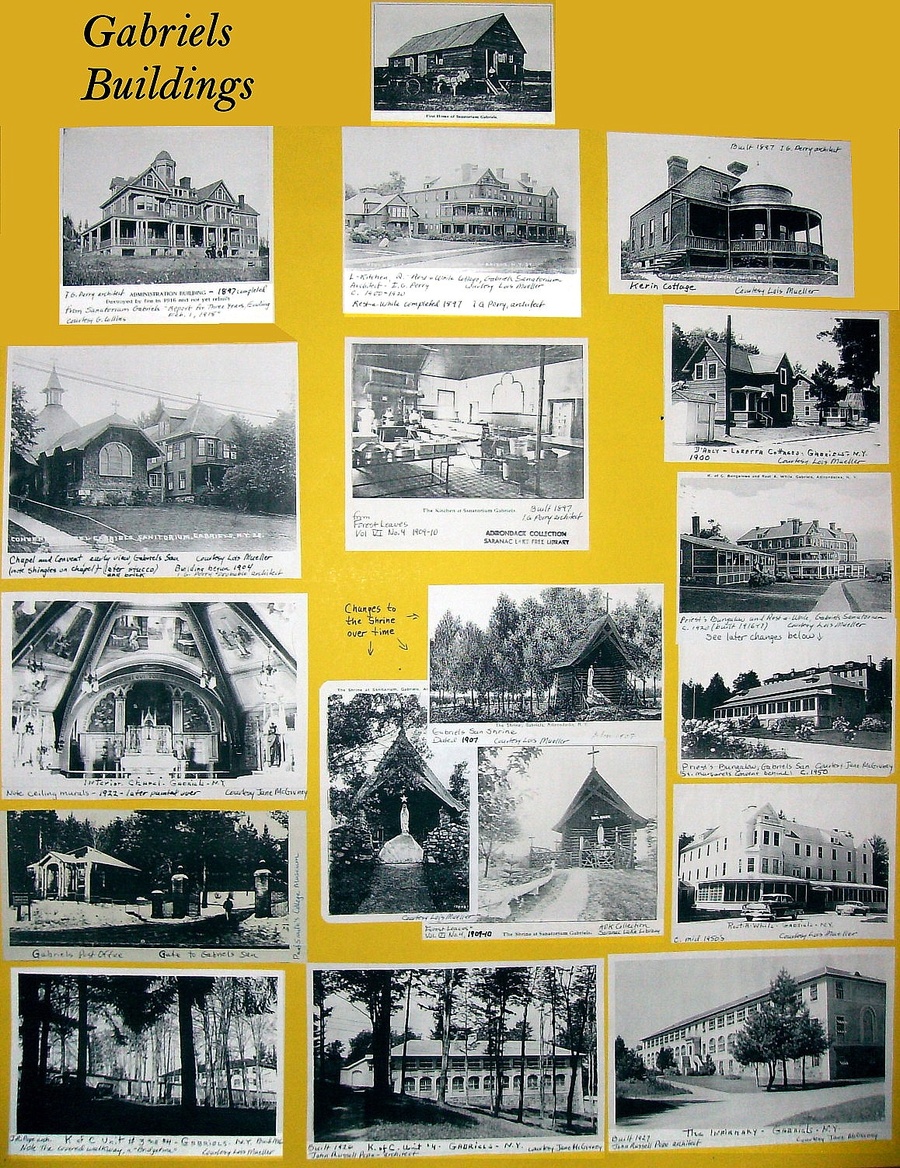 "Gabriels Buildings" by Pat and Tom Willis, photo of display taken February 2009.
"Gabriels Buildings" by Pat and Tom Willis, photo of display taken February 2009. 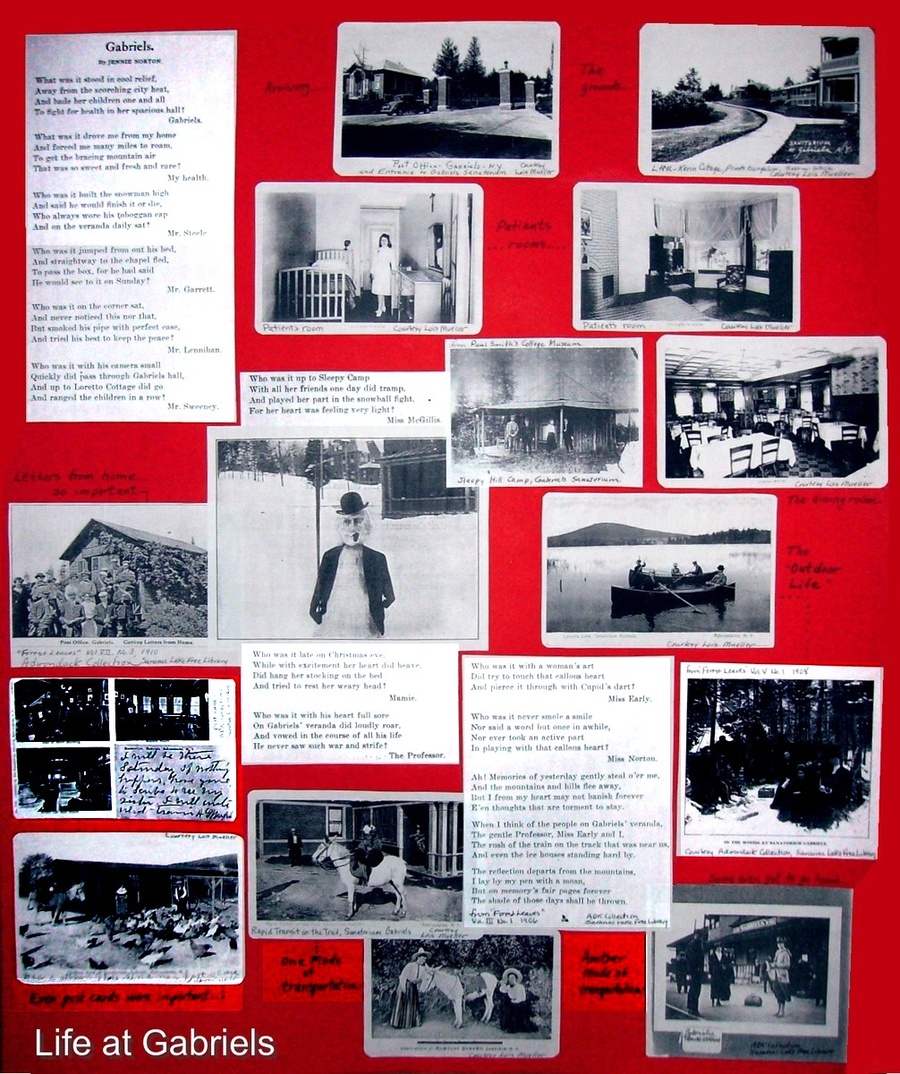 "Life at Gabriels San" by Pat and Tom Willis, photo of display taken February 2009.
"Life at Gabriels San" by Pat and Tom Willis, photo of display taken February 2009. 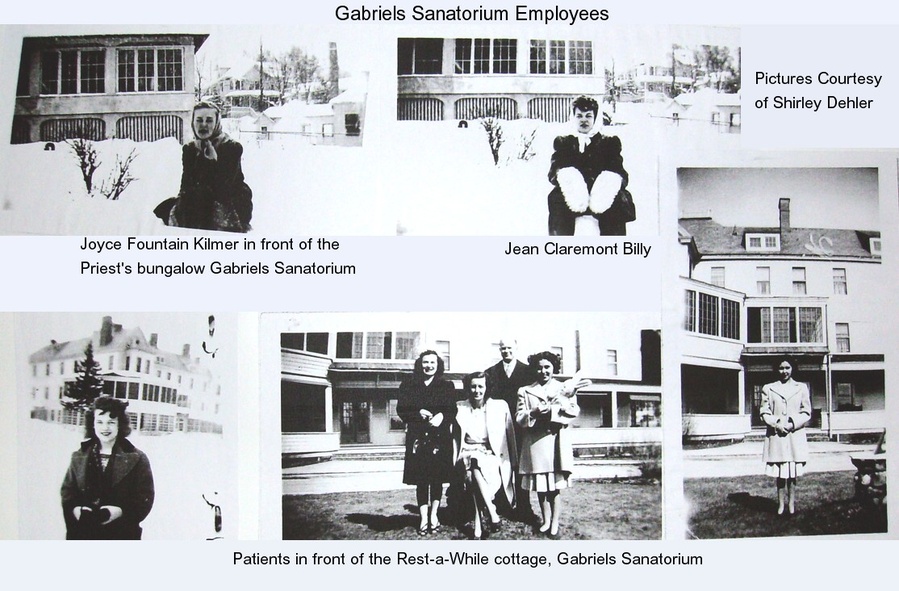 "Gabriels San Employees" by Pat and Tom Willis, photo of display taken 2/2009. The photo in the upper left, captioned Joyce Fountain Kilmer, is incorrectly labeled. Joyce's daughter Traci identified the photo and says that her mother's name was Joyce Fountain Hadynski.
"Gabriels San Employees" by Pat and Tom Willis, photo of display taken 2/2009. The photo in the upper left, captioned Joyce Fountain Kilmer, is incorrectly labeled. Joyce's daughter Traci identified the photo and says that her mother's name was Joyce Fountain Hadynski.
See also
External links
Footnotes
1. Adirondack Museum, "The War on Consumption"
2. Adirondack Daily Enterprise, 4/23/09.
3. This was sent from Millie Williams of the Uihlein Mercy Center to Natalie Leduc on November 2, 2006.
4. Brighton History Days have been held one weekend each summer since 1994, sponsored by the Brighton Architectural Heritage Committee.



